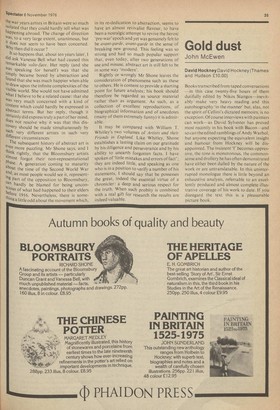Gold dust
John McEwen
David Hockney David Hockney (Thames and Hudson E10.00) Books transcribed from taped conversations —in this case twenty-five hours of them dutifully edited by Nikos Stangos—inevitably make very heavy reading and this autobiography 'in the manner' but, alas, not the spirit of Cellini's dictated memoirs, is no exception. Of course interviews with painters can work—as David Sylvester has proved most recently in his book with Bacon —and so can the edited ramblings of Andy Warhol, but anyone expecting the equivalent insight and humour from Hockney will be dis
appointed. The insistent becomes oppressive, the tone is monotonous, the commonsense and drollery he has often demonstrated have either been dulled by the nature of the work or are untranslatable. In this uninterrupted monologue there is little beyond an exhaustive analysis, referrable to an excellently produced and almost complete illustrative coverage of his work to date. If you disregard the text this is a pleasurable picture book. Hockney is revealed, much as he was in the film A Bigger Splash, as a shy man defensively engrossed in his own work. And the paintings themselves confirm this impression of someone growing more serious as the years go by. This progression is, strangely enough, an exact repetition of his career as a schoolboy. In the valediction of his last headmaster: 'He will be glad to be rid of the "figure of fun" so to establish himself as a sincere and serious person to steady work and merit.' But in London, as a student, he was up to his old tricks again. The English only really like their artists if they are characters and, even before he took the Royal College's gold medal in his gold suit and newly goldened hair, Hockney had become a 'character' in the Augustus John tradition. That he has benefited accordingly is indubitable. By the mid-'sixties he was the artistic equivalent of Bailey and The Shrimp, the most glamorous of all the symbols of swinging London. Today he is probably known to a wider audience than Henry Moore : 'In order to regain a measure
of privacy . . Hockney now moves back and forth between Los Angeles, London and Paris. He plans soon to add New York to his repertory of alternative homes,' writes Henry Geldzahler in his introduction. The cause of this largely self-inflicted inconvenience is not discussed. The golden image passes without mention. His success is considered only as a product of his painting and its problems lightly dismissed. As for the film: 'I was utterly shattered; 1 had no idea. I hadn't seen one inch of that film, I didn't expect the sound.' And we are asked to believe similar protestations of innocence with regard to business affairs in general.
The same stonewalling is no less dourly maintained in the discussion of other subjects which might betray his personality. It is not the private parts of his life which should be more fully expressed but rather his views, his knowledge, his preferences and, surely, his memories of other people. Of all his many encounters with the intellegentsia of the western world, only four or five mundane anecdotes have survived. His brief comments on such artistic issues of our time as the place of photography, the roles of figuration and abstraction, are no more than conventional asides. The work is the thing: not the work of other people, not the influence of other artists on his own work, but the process by which each image is
determined. His own pictures are his justification and interest. Early in the book he describes how his fellow painter, Ron Kitaj, persuaded him ie treat style as a subject, and in ambiguity he has also found constant inspiration: frog) 'Play within a Play' (1963) to 'Kerby (After Hogarth) Useful Knowledge' (1975 )—Pic" tures of pictures, pictures about pictures, '4 preoccupation which is inseparable from all exploration of style. This sort of analysis IS not so distant from the, physically, very, differently expressed work of the so-calle° 'conceptual' artists, who would on the surface appear to despise everything Hock fleY's traditionalism stands for. But here again his position is equivocal. He denies any interest in the trends of the past ten years on One page while overleaf expounding on the surely conceptual, pleasure of painting a picture in two weeks, 'The Splash', of an event which took two seconds; and eightY pages later acknowledging a debt to Gilbert and George, the 'living sculptures'.
Otherwise his commentary is modest
reasonably candid: the famous water 110;1, he lifted from Bernard Cohen's spaghett0. pictures; the plant at the foot of •h*, Taking Shower in Beverley Hills' WA8; painted in to cover up the mess he had t111°' of the figure's feet. His greatest enthusias° is reserved for discussions of techniclue; especially that which he has recently beet taught by Picasso's print-maker Cromill.c; lynck. But none of this can disguise a certalf undertow of boredom beneath the surface°, the narrative. Hockney's greatest distaste ff: a painter is for 'mainstream', middle-of-ft: road art. In his own work he strives 10 idiosyncratic. But he ought to be equa-, astringent in the expression of his vieivl.:1; which are a model of mainstream Engtlid evasion. Perhaps Henry Geldzahler wf/Itn, have made a better interviewer. In his itlf5 duction Geldzahler refers to HockneY,,e interest in Caspar David Friedrich and t:'s photographically inspired painter, Charteg Sheeler. Neither is mentioned again. As ,c work of reference this book would been better as a catalogue raisonne: as lige autobiography it all too fully illustrates to, quotation from Pevsner with which zahler evokes the atmosphere of the Lait fornian paintings: 'The English PortInt conceals more than it reveals, and wha'e, reveals it reveals with studied understaf nnent.'



















































 Previous page
Previous page